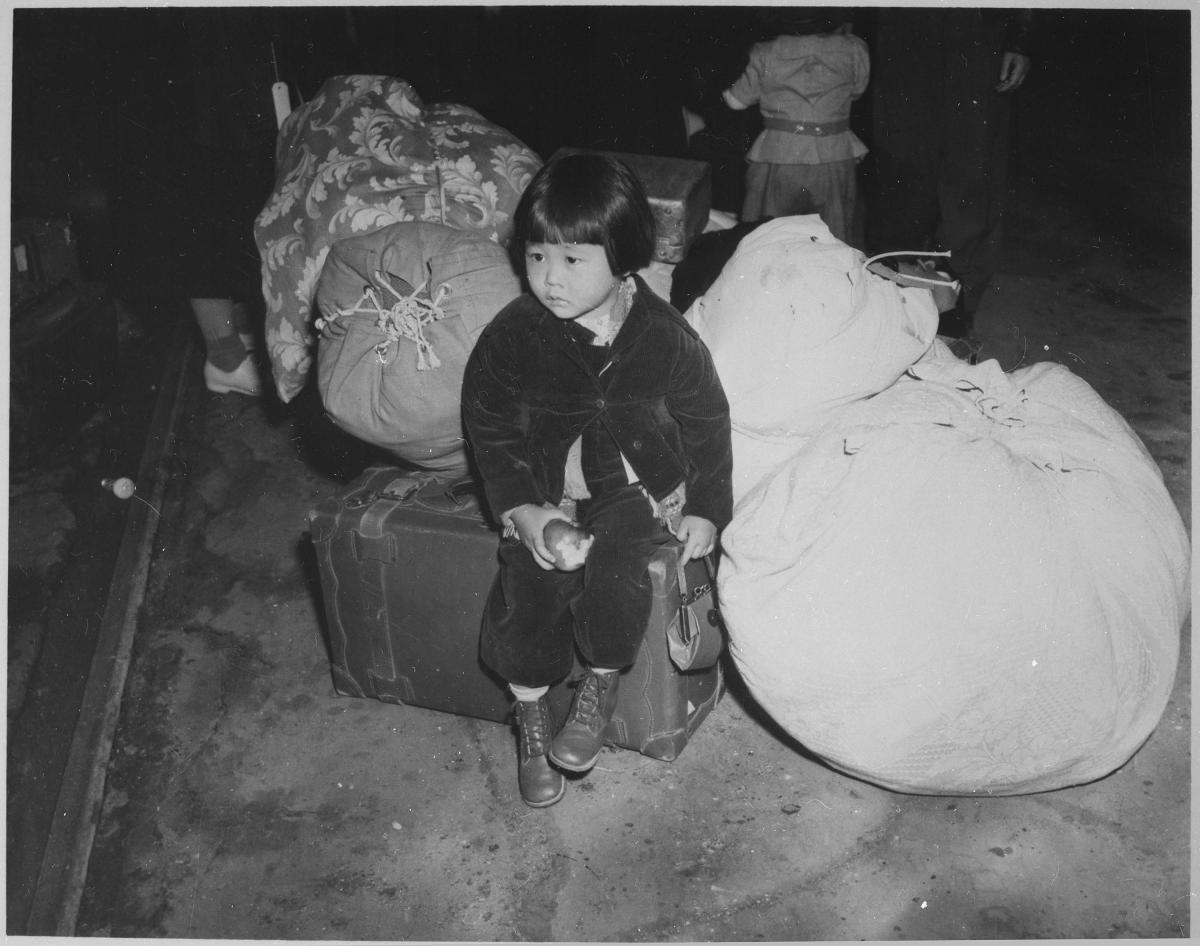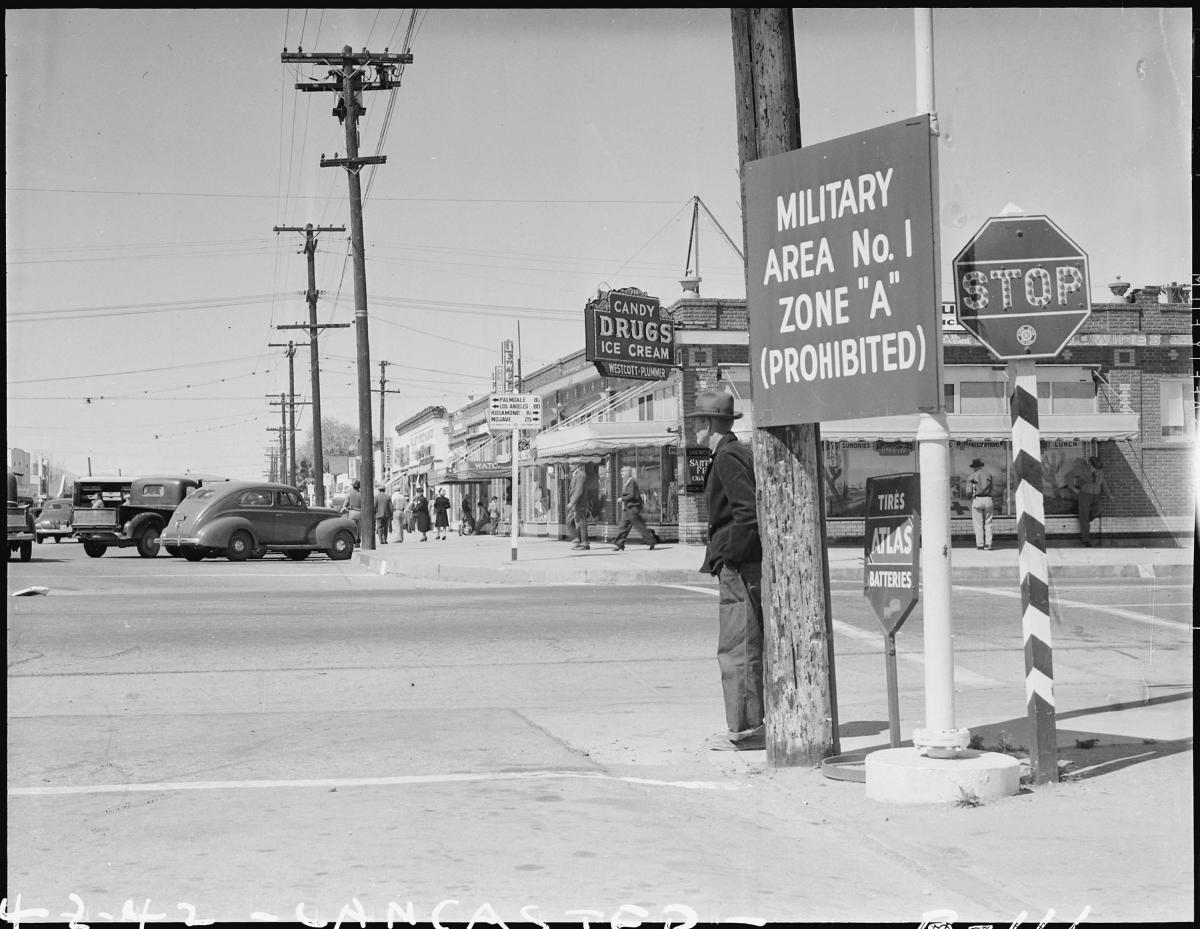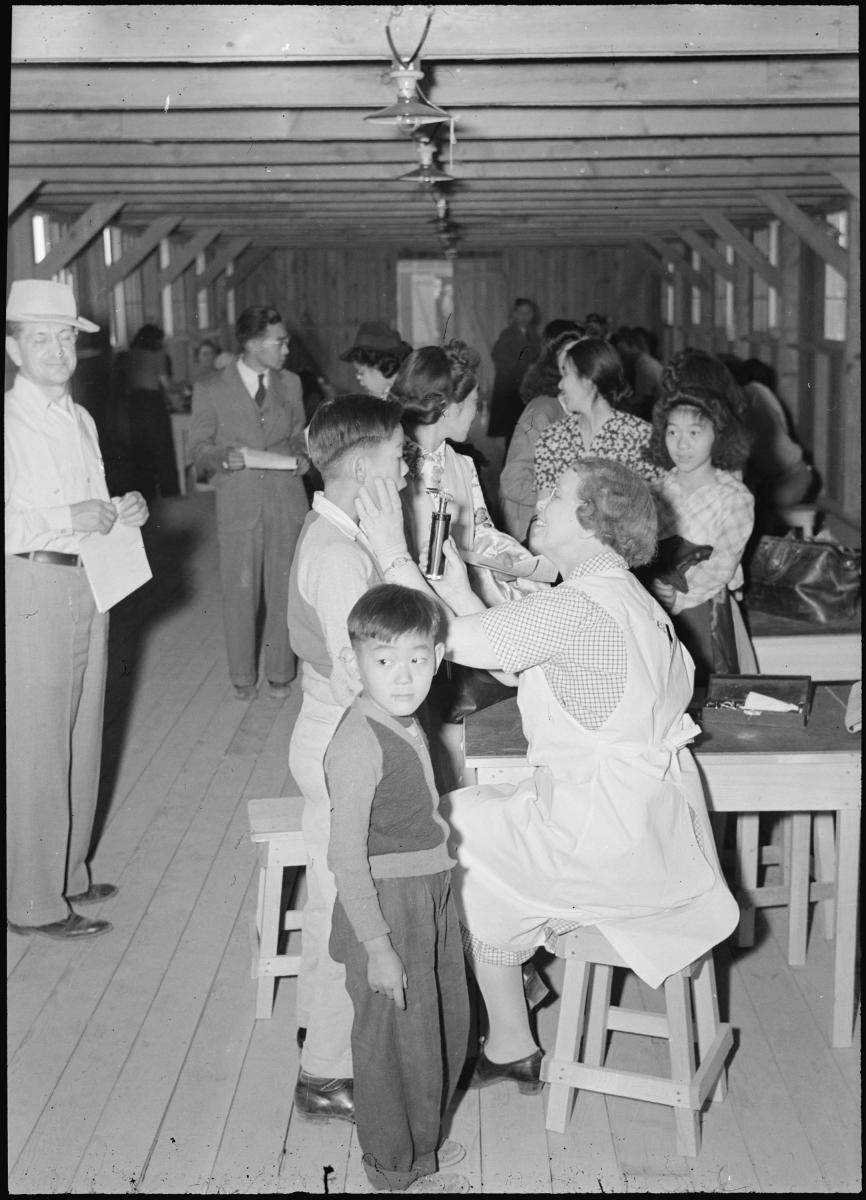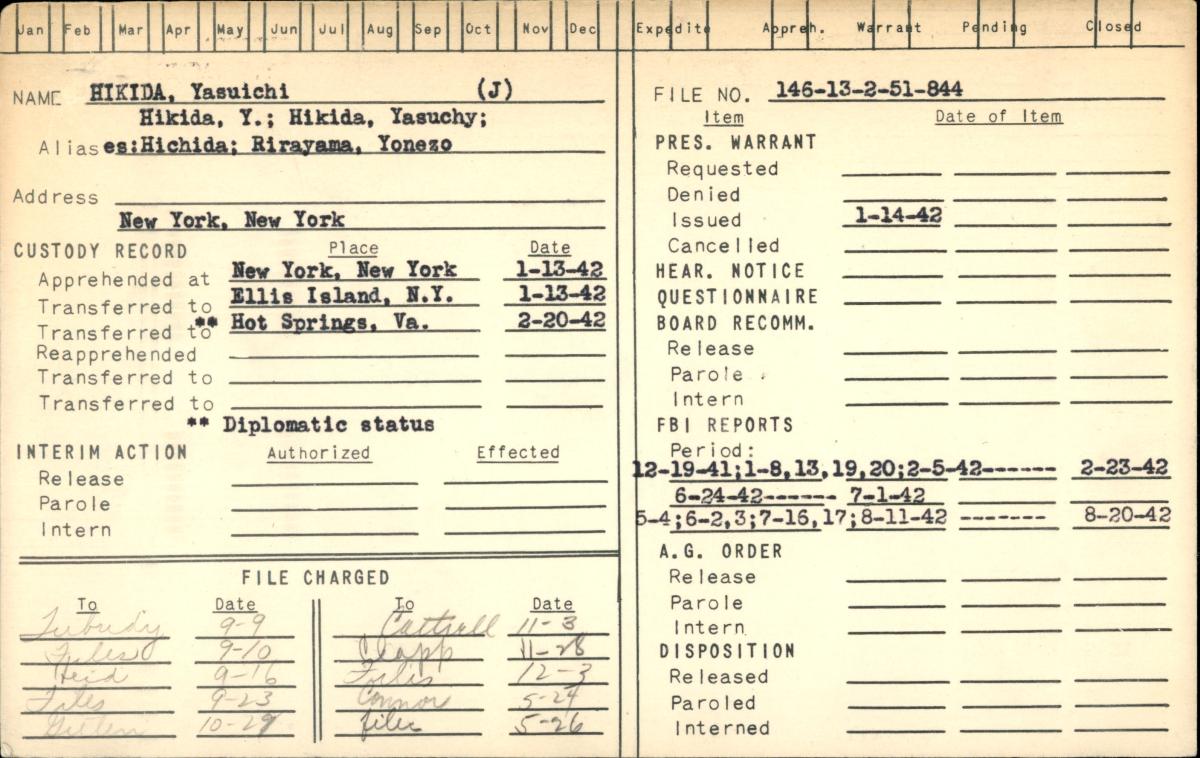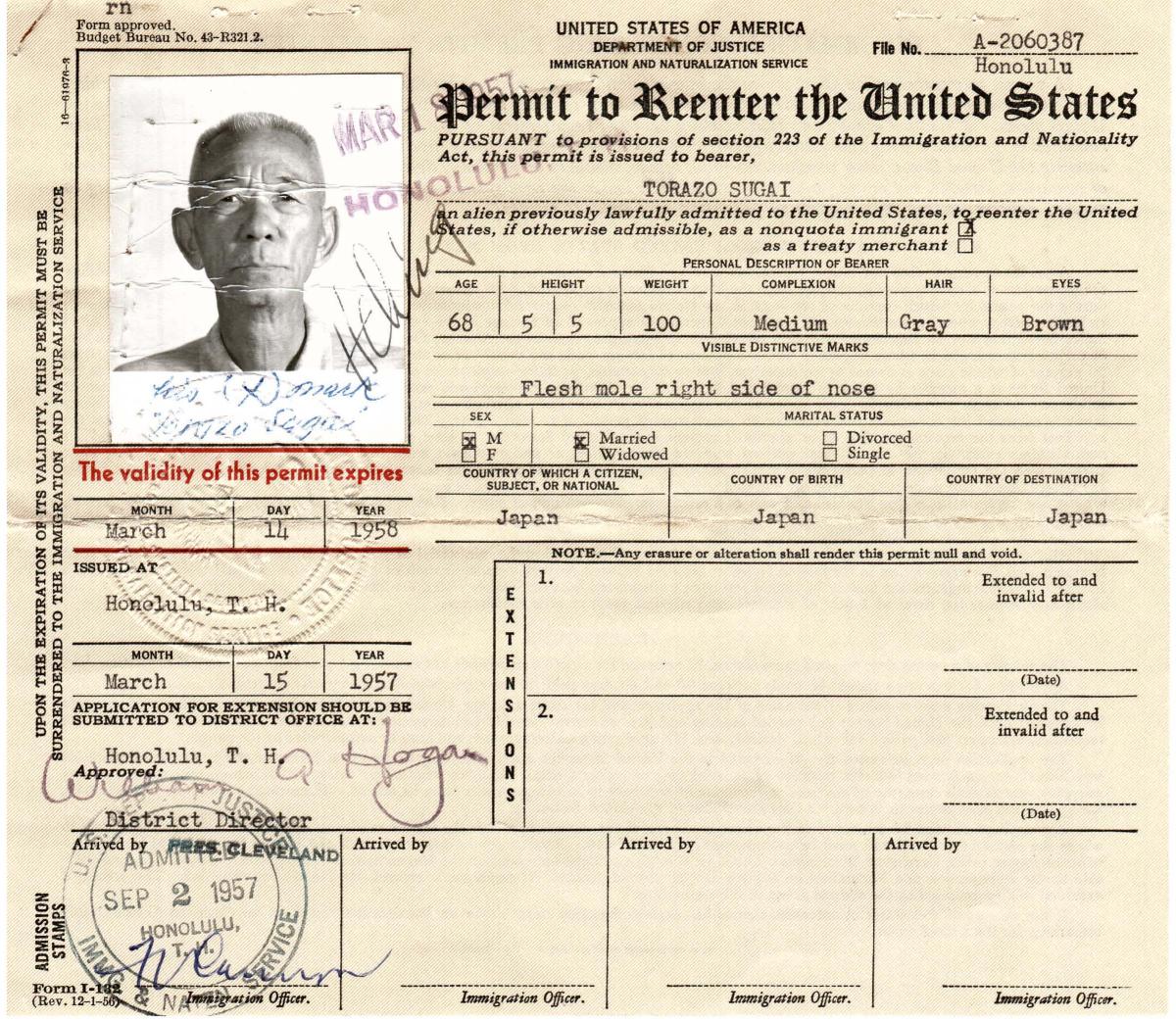
World War II Japanese American Incarceration: Researching an Individual or Family
Conducting genealogical research on formerly incarcerated Japanese and Japanese Americans can present a challenge for even the most adept researcher. Due to the involvement of multiple federal agencies in detaining and documenting individuals of Japanese descent (U.S. citizens, permanent residents, and those taken from U.S. territories and from Allied held nations), records may be found across several different record groups and at a number of National Archives and Records Administration (NARA) facilities across the country. The process of identifying individual or family records can be complicated due to the absence of any official master index and the fact that some of the formerly incarcerated were transferred between multiple camps.
This guide provides an overview of the types of records available for genealogical research and offers guidance on how to navigate them. You can continue your research with records at NARA by visiting us, contacting us online, or by hiring an independent researcher.
Getting Started
Although most persons of Japanese descent were incarcerated in one of the ten War Relocation Authority (WRA) camps, others were placed in camps run by the Department of Justice or the U.S. Army. A number of Nikkei (Japanese emigrants and their descendants) communities residing outside the Pacific Coast were never detained, but may have been documented by the federal government in other ways. Researchers should also consider accessing personnel records for those who served in the military or were employed by the federal government.
Knowing a person’s background will help determine what kind of records may be available. Consider starting your research by delving into the individual’s history and examining relevant documents. This initial step will help you collect some basic information such as:
- Name of individual
- Date and place of birth
- Place of residence before incarceration
Provide additional information, if known:
- Name of the camp or camps (for those who may have been transferred between multiple sites).
- These will include camps administered by the War Relocation Authority, Army, and/or the Department of Justice/Immigration and Naturalization Service.
- Name of the head of family and other family members
- Family number
- These were numbers assigned to a family entering the War Relocation Authority camp. While each record was assigned an “Individual Number,” members of one family usually have the same five numbers, with the letter denoting the position of the person in the family.
- Branch of military service
- Federal agency where employed
-
Some individual files have been indexed and are name searchable in the National Archives Catalog. If you are able to locate a Catalog record related to your individual or family, please contact the NARA office identified under the section “Archived Copy.”
A young girl waits with the family baggage before leaving by bus for an "assembly center" in the spring of 1942, by Clem Albers, California, April 1942. (National Archives Identifier: 539959)
Exclusion from Militarily Restricted Areas
Sign in Lancaster, CA, designating the military zone (National Archives Identifier: 536860)
The Western Defense Command (WDC) and Wartime Civil Control Administration (WCCA) Records (Record Group 499) concern the policy, administration, and the public reaction to the program to forcibly remove Japanese Americans from a large part of the West Coast, which was considered a militarily restricted area. Records include family files from the temporary detention camps, known as "assembly centers."
Wartime Civil Control Administration (WCCA) Microfilm Rolls
Records of the Assembly Centers
The records of the Assembly Center Branch document the administration of the temporary detention camps, including general operational procedures as well as detailed information on individual sites. Assembly Center records contain both administrative files and folders for individual families (called Family Folders).
- Copy of Records of the Assembly Centers, 1942–1945 (National Archives Identifier: 22476356)
- Copy of the General Correspondence of the Assembly Center Branch, 1942–1943 (National Archives Identifier: 22476358)
- Copy of the Index of the Records of the Assembly Center Branch, 1942–1945 (National Archives Identifier: 22476353)
Accessing Assembly Centers Microfilm Rolls
►Requests and questions may be submitted to the Textual Reference Branch at the National Archives at College Park, MD, at archives2reference@nara.gov.
War Relocation Authority Camps
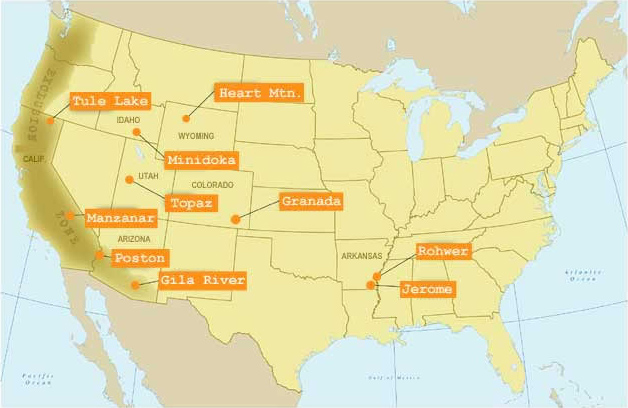
Ten War Relocation Centers were established in remote areas of the nation. (Courtesy of the National Park Service).
Researchers may wish to start their research in the War Relocation Authority (WRA) records (Record Group 210), as this federal agency administered the largest World War II incarceration program in the United States. These records can contain personal descriptive information on Japanese and Japanese Americans who were forcibly removed from the West Coast and detained in one of the ten WRA incarceration camps during the war.
Related records include documentation on the Japanese American Program (part of the Office of the Provost Marshal General [OPMG] [Record Group 389]). This program was established to determine the loyalty of those who were released from the WRA camps. Many were given permission to enlist in the military or to work in the civilian workforce.
War Relocation Authority (WRA) Case Files
The National Archives in Washington, DC, holds the case files of Japanese and Japanese Americans detained in WRA incarceration camps, known as "relocation centers." These camps initially imprisoned persons of Japanese ancestry, both citizens and noncitizens, who were forcibly removed from parts of California, Oregon, Washington, and Arizona that had been designated as military areas. As some Japanese enemy aliens were released from Army and Department of Justice-Immigration and Naturalization Service (DOJ-INS) camps, they were transferred to the WRA sites, where many reunited with their families.
The case files are found in Entry PI-77 22 in Record Group 210, Records of the War Relocation Authority (National Archives Identifier: 891305).
What you will find in these records:
The content of individual case files varies. In addition to including basic identifying information about the individual (such as their name, age, and physical description), case files may also contain:
- Medical records
- Property records
- School records
- Military service information
- WRA camp employment records
- Leave or discharge documentation
- Related correspondence
- Additional information about an individual's family members
Note: Not all case files contain each of these documents.
Preliminary medical examinations at the Poston WRA Camp (National Archives Identifier: 536090)
Starting Your Research
In addition to creating individual and family folders, the WRA collected statistical information upon arrival and near the closing of the camps. This data can be useful for locating information about those incarcerated in WRA camps, including family numbers.
Entering the WRA Camps, 1942
Evacuee Summary Data Cards, 1942–1946 (National Archives Identifier: 1055737): These computer punch cards consist of basic information gathered soon after Japanese American individuals and families entered the WRA camps. These data cards are particularly useful to locate individuals who left the camps early during the war (to enlist in the military, to work in the civilian workforce, or other), before the Final Accountability Rosters were created in 1944.
Data from the computer punch cards can be searched electronically via the Access to Archival Databases (AAD).
- For search tips, please see Search the Database page.
- For more information about this database, please see these Frequently Asked Questions (FAQs).
Closing the Camps, 1944–1946
Final Accountability Rosters of Evacuees, 1944–1946 (National Archives Identifier: 1055789): These rosters were created as the WRA camps prepared to close and contain valuable information including the trajectory of a person’s incarceration from the method of original entry (from an "assembly center," other institutions, Hawai'i, another "relocation center," or birth) to the type of final departure (indefinite leave, internment, repatriation/expatriation, segregation, relocation, or death). While these rosters are useful to locate individuals who were still in the WRA camps near the end of the war, including those transferred from DOJ-INS camps, the rosters will not include those who left earlier in the war.
- Digitized microfilms are arranged by WRA camp. Name searchable indexes are also available from Ancestry.com.
**Both the Final Rosters and Data Cards have been indexed into a combined Names Registry developed by Densho.org.
Accessing WRA Case Files
Researchers may request to view WRA case files on site at the National Archives in Washington, DC, or order copies of case files using the WRA case file request form.
In your request, please provide the following information so that our staff can locate the case file:
- Individual’s full name
- If the individual used a Japanese name and an English name, please provide both names.
- Individual's date of birth
- WRA camp or camps
If the individual of interest is not the head of their family, please also provide the following information:
- Head of family's name
- Head of family's date of birth
More questions?
►If you have any questions or for more information, contact the National Archives in Washington, DC, at archives1reference@nara.gov.
Records of the Provost Division and Japanese American Branch
Provost Division
Subject Correspondence Files Relating to the Internal Security Program, 1941–1946 (National Archives Identifier: 895317):
- Includes records related to the Loyalty Investigation Program (Boxes 1828–1831) and the Japanese American Program (Box 1851). Folder lists are available online in the National Archives Catalog.
Japanese American Branch
Records Relating to Persons of Japanese Ancestry Residing in the United States, 1942–1946 (National Archives Identifier: 953563):
- The records include minutes of meetings of the Japanese American Joint Board. The Board made determinations in cases of individuals' release from WRA camps or employment in specific industries. Files also include records about Japanese American men eligible for military service, including name, birthdate, prewar address, and WRA camp. Folder lists are available online in the National Archives Catalog.
Japanese American Personal Data Cards, 1942–1946 (National Archives Identifier: 953594):
- Data Cards contain personal information (such as name, address, and birthdate) and investigatory information (membership in certain organizations, character assessments, allegations regarding disloyal statements, prewar visits to Japan, and relatives living in Japan).
Accessing the records
►Requests and questions may be submitted to the Textual Reference Branch at the National Archives at College Park, MD, at archives2reference@nara.gov.
Enemy Alien Internment Facilities
The three government departments that administered and operated the Alien Enemy Control Program were:
- the Department of Justice (DOJ), which included the new Alien Enemy Control Unit (AECU), the Federal Bureau of Investigation (FBI), and the Immigration and Naturalization Service (INS);
- the War Department’s Office of the Provost Marshal General; and
- the Department of State, which included the new Special War Problems Division.
Complete lists or case files related to individuals detained in temporary enemy alien internment facilities are scarce. Most temporary facilities only held an individual until they were either released after their hearing or transferred to a permanent internment facility. Available indexes and case files at the National Archives mainly relate to those who were held in the permanent internment camps.
Please note that there is no master name index for the thousands of enemy aliens who were interned in the United States and its territories during World War II.
Alien Enemy Detention Facility: Crystal City, TX (National Archives Identifier: 13206)
Japanese Internee Card for Yasuichi Hikida (National Archives Identifier: 1090783)
Department of Justice (DOJ) Internee Cards and Case Files
The records of the Department of Justice (DOJ) (Record Group 60) include case files that document the DOJ's role in the Alien Enemy Control Program during World War II. The files include the arrest, investigations, and hearings of individuals of Japanese, German, and Italian descent who had already been targeted by the FBI and military intelligence agencies. Files also include internees taken from Latin America. Additional files related to internment can be found within the INS enemy alien case files.
What you will find in these records:
These individual case files generally document administrative proceedings to determine whether an alien enemy would be released, paroled, or interned for the duration of the war. The cases may include Federal Bureau of Investigation (FBI) reports, pleadings submitted to federal court, agency administrative or investigative files, agency and public correspondence, newspaper clippings, and transcripts of the Alien Enemy Board Hearings.
In the alphabetical index to the DOJ case files, you will find the person's:
- Name
- Alias
- Date of birth
- Address
- Case file number
- Dates of salient actions
- Remarks on the internees case
Conducting Initial Searches
World War II Japanese Internee Cards, 1941–1947 (National Archives Identifier: 720246): These index cards are name searchable in the National Archives Catalog. Enter the person’s name in the Search within this Series box.
Accessing DOJ Case Files
To request a DOJ case file, please provide the following information:
- Name of internee (include all names used)
- Date of birth
- Department of Justice case file number, if known
►Requests and questions about the DOJ case files may be submitted to the Textual Reference Branch at the National Archives at College Park, MD, at archives2reference@nara.gov.
Immigration (INS) Case Files
After receiving an order from the U.S. Attorney General for the internment of an enemy alien, the person was sent to an Enemy Alien Internment Facility run by the Immigration and Naturalization Service (INS) (Record Group 85). The INS oversaw all the Department of Justice and many of the Department of State internment facilities. INS field offices also maintained case files for the initial arrests of enemy aliens.
The INS ran twelve permanent enemy alien internment facilities:
INS records also include files from the Tule Lake Segregation Center, covering the immediate post-war period when the camp held those who renounced their U.S. citizenship, and those seeking repatriation and expatriation to Japan.
Conducting Initial Searches
INS Central Office:
- Indexes to the INS enemy alien case files are not available online. Proceed below for further information.
- Subject and Policy Files, 1906–1957 (National Archives Identifier: 559947): These INS records include files concerning INS-run Enemy Alien Internment Facilities. For further instructions on how to access these records, see INS Subject and Policy Files, 1906–1957.
INS office in Los Angeles:
- Enemy Alien Case Files, 1941–1948 (National Archives Identifier: 6217699): These case files relate to those apprehended in Southern California and may be name searchable in the National Archives Catalog. Enter the person’s name in the Search within this Series box.
Accessing INS Case Files
To request an INS Case File, please provide the following information:
- Name of internee (include all names used)
- Date of birth
- INS camp (if known)
►For records from the INS Central Office, contact the National Archives in Washington, DC, at archives1reference@nara.gov.
►For records from the Los Angeles INS office, contact the National Archives at Riverside at riverside.archives@nara.gov.
Enemy Alien Control Program in the U.S. Territories
Records of the Enemy Prisoner of War Information Bureau (part of the Office of the Provost Marshal General (OPMG) (Record Group 389) includes documents related to the Enemy Alien Control Program in the U.S. Territories. Files from Hawai'i include 1,202 case files for internees of Japanese ancestry.
Subject Files, 1942–1946 (National Archives Identifier: 833674):
- Hawai'i, Civilian Internees Folders: Records pertain to both Japanese and Japanese American civilian internees living in Hawai'i at the time of the Pearl Harbor attack. Name searchable in the National Archives Catalog. Enter the person’s name in the Search within this Series box. Here are the query results for the full list.
- Hawai'i: Enemy Alien General File (National Archives Identifier: 900260): This one file documents the deportation of Japanese Americans to the mainland.
- Hawai'i, Return Groups Files: Records consist of lists of Japanese Americans deported to the mainland and later returned, or offered the option to return, to Hawai'i at war's end. Here are the query results for the full list.
Records Relating to Japanese Civilian Internees During World War II (National Archives Identifier: 872144): Consists of files of Japanese nationals (and possibly U.S. citizens) interned in the United States, including those who were apprehended from overseas (Peru, Guam, and Saipan).
Records from the Military Government of the Territory of Hawai'i (MGH) (Record Group 494) include internee case files and lists:
- Internee Release Forms, 1942–1945 (National Archives Identifier: 1088866)
- Internee Case Files, December 15, 1941–1945 (National Archives Identifier: 1073970)
- Lists of Names of Japanese Alien Internees, 1945 (National Archives Identifier: 1089727)
- Internee Property Case Files, 1943–1945 (National Archives Identifier: 1112476)
- Index of Paroled Enemy Aliens, 1942–1943 (National Archives Identifier: 7873232)
Accessing OPMG and MGH Records
►Requests and questions may be submitted to the Textual Reference Branch at the National Archives at College Park, MD, at archives2reference@nara.gov.
Enemy Alien Diplomats and Latin Americans Deported to the United States
The Department of State (Record Group 59) managed the internment of enemy alien diplomats and Latin Americans deported to the United States. The State Department was also responsible for negotiating a civilian internees exchange, facilitating the return of U.S. citizens held in Axis nations in return for the repatriation of Axis citizens detained in the United States. Records include hearings to determine whether former enemy aliens could return to their Latin American country.
Records:
Reports on Interned Enemy Aliens, 1942–1947 (National Archives Identifier: 719525)
Transcripts of Proceedings before the Hearing Board of the Alien Enemy Control Section, 1946 (National Archives Identifier: 657806)
Subject Files, 1939–1955 (National Archives Identifier: 2173219): Includes documentation on internees from Latin America and case files on Japanese nationals who died in the camps.
Accessing State Department Records
►Requests and questions may be submitted to the Textual Reference Branch in College Park, MD, at archives2reference@nara.gov.
Military and Civilian Service
Because most military branches refused to enlist persons of Japanese descent during World War II, the majority of Nisei (Japanese Americans whose parents emigrated from Japan) served in the U.S. Army, while others (both Nisei and Issei [first-generation immigrants from Japan]) were employed in civilian roles including the Office of Strategic Services and the Cadet Nurse Corps. While personnel records may be requested from the National Archives at St. Louis or the National Personnel Records Center, several online name indexes are also available for researchers to search for information.
Agency Official Personnel Folders and Official Military Personnel Files
Civilian Official Personnel Folders (OPF) and Official Military Personnel Files (OMPF) are held at the National Archives at St. Louis or the National Personnel Records Center. The location of a particular folder will depend on the individual's dates of service.
Certain basic information is required to locate personnel records including:
For Agency Official Personnel Files:
- Full name at time of service (for women, include married and maiden names)
- Date and place of birth
- Federal agency where employed
- Dates of service
- Social security number, if known
- Names of parents, spouse, and/or children who might have been listed as next of kin or beneficiaries at the time of employment
Coat of Arms for the 100th Infantry Battalion (National Archives Identifier: 7260301)
To submit requests and questions on OPFs:
- If the federal civil servant's employment ended before 1952, contact the National Archives at St. Louis at stl.archives@nara.gov.
- If the federal civil servant's employment ended in 1952 or after, contact the National Personnel Records Center (NPRC).
For Military Official Personnel Files (OMPF):
- Full name at time of service
- Date and place of birth
- Service number
- Branch of service
- Dates of service
For records affected by the 1973 Fire, additional information—such as place of discharge; last assigned unit; and place of entry into service—may be useful.
Requests for OMPFs may be submitted online: Request Military Service Records. To request additional assistance:
- If the veteran separated from military service before 1962, contact the National Archives at St. Louis at stl.archives@nara.gov.
- If the veteran separated from military service in 1962 or after, contact the National Personnel Records Center (NPRC).
Online Indexes
National Archives and Records Administration (Record Group 64)
World War II Army Enlistment Records, June 1, 2002–September 30, 2002 (National Archives Identifier: 604357)
- The Army Serial Number Enlistment Card Records table has records for almost nine million men and women who enlisted in the Army and the Women's Army Auxiliary Corps.
- The database is name searchable in the Access to Archival Database (AAD).
Public Health Service (Record Group 90)
Cadet Nurse Corps Files, 1943–1948 (National Archives Identifier: 5605027)
- Membership cards are name searchable in Ancestry.com: U.S., World War II Cadet Nursing Corps Card Files, 1942–1948.
Office of Strategic Services (Record Group 226)
Personnel Files of the Office of Strategic Services, 1942–ca. 1962 (National Archives Identifier: 1593270):
- These index cards are name searchable in the National Archives Catalog. Enter the person’s name in the Search within this Series box.
►Requests and questions about these records may be submitted to the Textual Reference Branch at the National Archives at College Park, MD, at archives2reference@nara.gov.
Renouncing—and Restoring—U.S. Citizenship
Public Law 78-405, commonly referred to as the Renunciation Act of 1944 or the Denationalization Act of 1944, was signed into law on July 1, 1944. This law amended the Nationality Act of 1940 and allowed Americans within the United States renounce their citizenship. The National Archives holds records that document both the application process to renounce and the legal proceedings to restore U.S. citizenship for Japanese Americans.
Applications for Renunciation, Repatriation and Expatriation
Department of Justice (Record Group 60)
Class 146-54 (Voluntary Renunciation of Citizenship) Litigation Case Files and Enclosures, 1944–1972 (National Archives Identifier: 20761625) and Index (National Archives Identifier: 159982441)
►Requests and questions about these records may be submitted to the Textual Reference Branch at the National Archives at College Park, MD at archives2reference@nara.gov.
Immigration and Naturalization Service (INS) (Record Group 85)
General Files (Tule Lake), 1945–1946 (National Archives Identifier: 5717237)
►Requests and questions about these records may be submitted to the National Archives in Washington, D.C. at archives1reference@nara.gov.
Legal Challenges
Several lawsuits were filed in the U.S. District Courts (Record Group 21) to prevent deportation and reinstate U.S. citizenship.
Northern District of California (San Francisco)
A good place to start searching for those who renounced is in the class action suit, Tadayasu Abo v. Clark, Civil no. 25294 (National Archives Identifier: 357434775), where the majority of Japanese Americans filed affidavits to reclaim their citizenship.
►Requests and questions about the affidavits in the Abo case may be submitted to the National Archives at San Francisco at sanbruno.archives@nara.gov.
Central District of California (Los Angeles)
Lawsuits were also filed individually or in smaller groups in the federal court in Los Angeles.
►Requests and questions about cases filed in Southern California may be submitted to the National Archives at Riverside at riverside.archives@nara.gov.
Post-War Redress and Reparations
The post-war redress movement—seeking financial compensation, and public recognition and apology for the forced removal and confinement—took decades to bear fruit. While the Claims Act of 1948 provided token compensation for lost property, only with the passing of the Civil Liberties Act of 1988 did the formerly incarcerated receive more substantial redress, including a public apology. Records at NARA include case files for claims filed under the 1948 Act, claims filed under the 1988 Act, and testimonies from the public hearings held by the Commission on Wartime Relocation and Internment of Civilians (CWRIC).
Japanese American Claims Act Case Files, under 1948 law
About the Claims
The Japanese American Evacuation Claims Act of July 2, 1948, provided compensation for losses of real and personal property to Japanese American citizens removed from the West Coast during World War II. The vast majority of the approximately 26,550 claims filed were compensated for $2,500 or less. The program was administered by the Justice Department, which later set a $100,000 limit on each claim. Approximately $37 million was awarded.
What you will find in these records, part of Department of Justice (DOJ) (Record Group 60):
- Description of the compensation and amounts requested by the claimant
- Award amount
- Basis for the decision
How to search these records:
Published Adjudications
The publication Adjudications of the Attorney General of the United States, Volume 1, Precedent Decisions under the Japanese American Evacuation Claims Act (GPO: Washington, DC), can serve as a finding aid. Link to chapters from list of claimant names, file numbers, and dates.
- Go to the Adjudications main page
- Look for the name of the person you are researching.
- If you find the person, you can review the published decisions online by clicking on the link in the File Number column.
Case Files
Class 146-35 (Japanese American Claims Act) Litigation Case Files and Enclosures, 1942–1962 (National Archives Identifier: 783824):
- Case files are name searchable in the National Archives Catalog. Enter the person’s name in the Search within this Series box. Only precedent-setting adjudications, claims settled by the Court of Claims, and a selected representative sample of cases were preserved.
Accessing the records
►Requests and questions about the claims case files may be submitted to the Textual Reference Branch at the National Archives at College Park, MD, at archives2reference@nara.gov.
Japanese American Redress Case Files, Under 1988 Law
Office of Redress Administration (ORA) for Restitution Payment
The Office of Redress Administration (ORA) (part of Department of Justice [Record Group 60]) was established in 1988. ORA was charged with administering a ten-year program to provide a tax-free restitution payment of $20,000 to eligible individuals of Japanese ancestry.
To be eligible for restitution, an applicant had to have been:
- alive on August 10, 1988,
- a U.S. citizen or permanent resident alien during the internment period December 7, 1941, to June 30, 1946,
- a person of Japanese ancestry, or the spouse or parent of a person of Japanese ancestry, and
- evacuated, relocated, interned, or otherwise deprived of liberty or property as a result of federal government action during the internment period and based solely on their Japanese ancestry.
What you will find in these records
The case files consist of written correspondence from the individual, copies of their personal credentials and supporting documentation. Each case is closed by either a letter of ineligibility or a payment document.
How to search these records
Please note: the index to these records is not currently available online.
Accessing the records
Researchers may request an index search for payments made by the Office of Redress Administration by providing the following information in their request:
- Name of individual
- Date of birth
- Residence at the time the application for restitution payments was submitted (if known)
►Requests for an index search or other questions may be submitted to the Textual Reference Branch at the National Archives at College Park, MD at archives2reference@nara.gov.
CWRIC Public Hearings and Testimonies
About the Commission on Wartime Relocation and Internment of Civilians (CWRIC) (Record Group 220)
The CWRIC was set up to review the facts and circumstances surrounding the forced removal and incarceration, and its impact on American citizens and permanent residents.
What you will find in these records
These records reflect the Commission's twenty days of hearings and testimonies from more than 750 witnesses held between July and December 1981, in cities across the country. These witnesses included Japanese Americans and Aleuts who had lived through the events of World War II, former government officials who ran the incarceration programs, public figures, organizations such as the Japanese American Citizens League, interested citizens, historians, and other professionals who had studied the subjects of the Commission's inquiry. Materials also include publications, reports, press releases, photographs, newspaper clippings, and transcripts that relate to the hearings. The transcripts contain many personal narratives that directly capture the intangible losses stemming from the wartime policies by the U.S. government.
Search the National Archives Catalog for descriptions of the records
Abstracts of Witness Testimony, 1981 (National Archives Identifier: 734703)
Solicited Testimony Files, 1981-1982 (National Archives Identifier: 734695)
Transcripts of Public Hearings, 1981 (National Archives Identifier: 734681)
Accessing the records
If you or your relative testified during the public hearings, we may hold records of the testimony. To request these records, please provide the following information:
- Name of witness
- Location of testimony
- Date of testimony
►Requests and questions may be submitted to the Textual Reference Branch in the National Archives at College Park, MD, at archives2reference@nara.gov.
